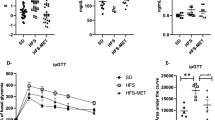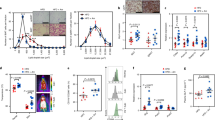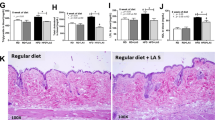Abstract
Aim:
Accumulating evidence shows that lipopolysaccharides (LPS) derived from gut gram-negative bacteria can be absorbed, leading to endotoxemia that triggers systemic inflammation and insulin resistance. In this study we examined whether metformin attenuated endotoxemia, thus improving insulin signaling in high-fat diet fed mice.
Methods:
Mice were fed a high-fat diet for 18 weeks to induce insulin resistance. One group of the mice was treated with oral metformin (100 mg·kg−1·d−1) for 4 weeks. Another group was treated with LPS (50 μg·kg−1·d−1, sc) for 5 days followed by the oral metformin for 10 d. Other two groups received a combination of antibiotics for 7 d or a combination of antibiotics for 7 d followed by the oral metformin for 4 weeks, respectively. Glucose metabolism and insulin signaling in liver and muscle were evaluated, the abundance of gut bacteria, gut permeability and serum LPS levels were measured.
Results:
In high-fat fed mice, metformin restored the tight junction protein occludin-1 levels in gut, reversed the elevated gut permeability and serum LPS levels, and increased the abundance of beneficial bacteria Lactobacillus and Akkermansia muciniphila. Metformin also increased PKB Ser473 and AMPK T172 phosphorylation, decreased MDA contents and redox-sensitive PTEN protein levels, activated the anti-oxidative Nrf2 system, and increased IκBα in liver and muscle of the mice. Treatment with exogenous LPS abolished the beneficial effects of metformin on glucose metabolism, insulin signaling and oxidative stress in liver and muscle of the mice. Treatment with antibiotics alone produced similar effects as metformin did. Furthermore, the beneficial effects of antibiotics were addictive to those of metformin.
Conclusion:
Metformin administration attenuates endotoxemia and enhances insulin signaling in high-fat fed mice, which contributes to its anti-diabetic effects.
Similar content being viewed by others
Log in or create a free account to read this content
Gain free access to this article, as well as selected content from this journal and more on nature.com
or
References
Reaven GM . Pathophysiology of insulin resistance in human disease. Physiol Rev 1995; 75: 473–86.
Backhed F, Manchester JK, Semenkovich CF, Gordon JI . Mechanisms underlying the resistance to diet-induced obesity in germ-free mice. Proc Natl Acad Sci U S A 2007; 104: 979–84.
Bradlow HL . Obesity and the gut microbiome: pathophysiological aspects. Horm Mol Biol Clin Investig 2014; 17: 53–61.
Udayappan SD, Hartstra AV, Dallinga-Thie GM, Nieuwdorp M . Intestinal microbiota and faecal transplantation as treatment modality for insulin resistance and type 2 diabetes mellitus. Clin Exp Immunol 2014; 177: 24–9.
Ramakrishna BS . Role of the gut microbiota in human nutrition and metabolism. J Gastroenterol Hepatol 2013; 28 Suppl 4: 9–17.
Prajapati B, Jena PK, Rajput P, Purandhar K, Seshadri S . Understanding and modulating the Toll like Receptors (TLRs) and NOD like receptors (NLRs) cross talk in type 2 diabetes. Curr Diabetes Rev 2014; 10: 190–200.
Houstis N, Rosen ED, Lander ES . Reactive oxygen species have a causal role in multiple forms of insulin resistance. Nature 2006; 440: 944–8.
Uruno A, Yagishita Y, Yamamoto M . The Keap1-Nrf2 system and diabetes mellitus. Arch Biochem Biophys 2015; 566: 76–84.
He HJ, Wang GY, Gao Y, Ling WH, Yu ZW, Jin TR . Curcumin attenuates Nrf2 signaling defect, oxidative stress in muscle and glucose intolerance in high fat diet-fed mice. World J Diabetes 2012; 3: 94–104.
Yu Z, Shao W, Chiang Y, Foltz W, Zhang Z, Ling W, et al. Oltipraz upregulates the nuclear factor (erythroid-derived 2)-like 2 [corrected](NRF2) antioxidant system and prevents insulin resistance and obesity induced by a high-fat diet in C57BL/6J mice. Diabetologia 2011; 54: 922–34.
Yang Y, Li W, Li Y, Wang Q, Gao L, Zhao J . Dietary Lycium barbarum polysaccharide induces Nrf2/ARE pathway and ameliorates insulin resistance induced by high-fat via activation of PI3K/AKT signaling. Oxid Med Cell Longevity 2014; 2014: 145641. Epub 2014 Jun 22.
Cheng AS, Cheng YH, Chiou CH, Chang TL . Resveratrol upregulates Nrf2 expression to attenuate methylglyoxal-induced insulin resistance in Hep G2 cells. J Agric Food Chem 2012; 60: 9180–7.
Tan Y, Ichikawa T, Li J, Si Q, Yang H, Chen X, et al. Diabetic downregulation of Nrf2 activity via ERK contributes to oxidative stress-induced insulin resistance in cardiac cells in vitro and in vivo. Diabetes 2011; 60: 625–33.
Lee H, Ko G . Effect of metformin on metabolic improvement and gut microbiota. Appl Environ Microbiol 2014; 80: 5935–43.
Napolitano A, Miller S, Nicholls AW, Baker D, Van Horn S, Thomas E, et al. Novel gut-based pharmacology of metformin in patients with type 2 diabetes mellitus. PLoS One 2014; 9: e100778. eCollection 2014.
Shin NR, Lee JC, Lee HY, Kim MS, Whon TW, Lee MS, et al. An increase in the Akkermansia spp population induced by metformin treatment improves glucose homeostasis in diet-induced obese mice. Gut 2014; 63: 727–35.
Everard A, Belzer C, Geurts L, Ouwerkerk JP, Druart C, Bindels LB, et al. Cross-talk between Akkermansia muciniphila and intestinal epithelium controls diet-induced obesity. Proc Natl Acad Sci U S A 2013; 110: 9066–71.
Moreira AP, Texeira TF, Ferreira AB, Peluzio MC, Alfenas RC . Influence of a high-fat diet on gut microbiota, intestinal permeability and metabolic endotoxaemia. Br J Nutr 2012; 108: 801–9.
Carvalho BM, Guadagnini D, Tsukumo DM, Schenka AA, Latuf-Filho P, Vassallo J, et al. Modulation of gut microbiota by antibiotics improves insulin signalling in high-fat fed mice. Diabetologia 2012; 55: 2823–34.
Shalaby MA, Latif HA, Sayed ME . Interaction of insulin with prokinetic drugs in STZ-induced diabetic mice. World J Gastrointest Pharmacol Ther 2013; 4: 28–38.
Yu Z, Morrison M . Improved extraction of PCR-quality community DNA from digesta and fecal samples. Biotechniques 2004; 36: 808–12.
Cabreiro F, Gems D . Worms need microbes too: microbiota, health and aging in Caenorhabditis elegans. EMBO Mol Med 2013; 5: 1300–10.
Cabreiro F, Au C, Leung KY, Vergara-Irigaray N, Cocheme HM, Noori T, et al. Metformin retards aging in C elegans by altering microbial folate and methionine metabolism. Cell 2013; 153: 228–39.
Cani PD, Amar J, Iglesias MA, Poggi M, Knauf C, Bastelica D, et al. Metabolic endotoxemia initiates obesity and insulin resistance. Diabetes 2007; 56: 1761–72.
Pappo I, Becovier H, Berry EM, Freund HR . Polymyxin B reduces cecal flora, TNF production and hepatic steatosis during total parenteral nutrition in the rat. J Surg Res 1991; 51: 106–12.
Shaw RJ, Lamia KA, Vasquez D, Koo SH, Bardeesy N, Depinho RA, et al. The kinase LKB1 mediates glucose homeostasis in liver and therapeutic effects of metformin. Science 2005; 310: 1642–6.
Foretz M, Hebrard S, Leclerc J, Zarrinpashneh E, Soty M, Mithieux G, et al. Metformin inhibits hepatic gluconeogenesis in mice independently of the LKB1/AMPK pathway via a decrease in hepatic energy state. J Clin Invest 2010; 120: 2355–69.
Stephenne X, Foretz M, Taleux N, van der Zon GC, Sokal E, Hue L, et al. Metformin activates AMP-activated protein kinase in primary human hepatocytes by decreasing cellular energy status. Diabetologia 2011; 54: 3101–10.
Tadie JM, Bae HB, Deshane JS, Bell CP, Lazarowski ER, Chaplin DD, et al. Toll-like receptor 4 engagement inhibits adenosine 5'-monophosphate-activated protein kinase activation through a high mobility group box 1 protein-dependent mechanism. Mol Med 2012; 18: 659–68.
Wang L, Li L, Ran X, Long M, Zhang M, Tao Y, et al. Lipopolysaccharides reduce adipogenesis in 3T3-L1 adipocytes through activation of NF-kappaB pathway and downregulation of AMPK expression. Cardiovasc Toxicol 2013; 13: 338–46.
Okamura H, Yoshida K, Sasaki E, Qiu L, Amorim BR, Morimoto H, et al. Expression of PTEN and Akt phosphorylation in lipopolysaccharide-treated NIH3T3 cells. Cell Biol Int 2007; 31: 119–25.
Hou R, Zhang J, Yin T, Cao H, Zhang N, Li X, et al. Upregulation of PTEN by peroxynitrite contributes to cytokine-induced apoptosis in pancreatic beta-cells. Apoptosis 2010; 15: 877–86.
Song P, Wu Y, Xu J, Xie Z, Dong Y, Zhang M, et al. Reactive nitrogen species induced by hyperglycemia suppresses Akt signaling and triggers apoptosis by upregulating phosphatase PTEN (phosphatase and tensin homologue deleted on chromosome 10) in an LKB1-dependent manner. Circulation 2007; 116: 1585–95.
Rojo AI, Rada P, Mendiola M, Ortega-Molina A, Wojdyla K, Rogowska-Wrzesinska A, et al. The PTEN/NRF2 axis promotes human carcinogenesis. Antioxid Redox Signal 2014; 21: 2498–514.
Ashabi G, Khalaj L, Khodagholi F, Goudarzvand M, Sarkaki A . Pre-treatment with metformin activates Nrf2 antioxidant pathways and inhibits inflammatory responses through induction of AMPK after transient global cerebral ischemia. Metab Brain Disease 2015; (3): 747–54.
Tomasi ML, Ryoo M, Yang H, Iglesias AA, Ko KS, Lu SC . Molecular mechanisms of lipopolysaccharide-mediated inhibition of glutathione synthesis in mice. Free Radic Biol Med 2014; 68: 148–58.
Dhungana S, Merrick BA, Tomer KB, Fessler MB . Quantitative proteomics analysis of macrophage rafts reveals compartmentalized activation of the proteasome and of proteasome-mediated ERK activation in response to lipopolysaccharide. Mol Cell Proteomics 2009; 8: 201–13.
Rao J, Qian X, Li G, Pan X, Zhang C, Zhang F, et al. ATF3-mediated NRF2/HO-1 signaling regulates TLR4 innate immune responses in mouse liver ischemia/reperfusion injury. Am J Transplant 2015; 15: 76–87.
Kim J, Kwak HJ, Cha JY, Jeong YS, Rhee SD, Kim KR, et al. Metformin suppresses lipopolysaccharide (LPS)-induced inflammatory response in murine macrophages via activating transcription factor-3 (ATF-3) induction. J Biol Chem 2014; 289: 23246–55.
Thimmulappa RK, Scollick C, Traore K, Yates M, Trush MA, Liby KT, et al. Nrf2-dependent protection from LPS induced inflammatory response and mortality by CDDO-imidazolide. Biochem Biophys Res Commun 2006; 351: 883–9.
Carvalho BM, Saad MJ . Influence of gut microbiota on subclinical inflammation and insulin resistance. Mediators Inflamm 2013; 2013: 986734.
Acknowledgements
This work was supported by a National Natural Science Foundation of China (No 81270886 to Zhi-wen YU).
Author information
Authors and Affiliations
Corresponding author
Additional information
Supplementary information are available at the Acta Pharmacologica Sinica's website.
Rights and permissions
About this article
Cite this article
Zhou, Zy., Ren, Lw., Zhan, P. et al. Metformin exerts glucose-lowering action in high-fat fed mice via attenuating endotoxemia and enhancing insulin signaling. Acta Pharmacol Sin 37, 1063–1075 (2016). https://doi.org/10.1038/aps.2016.21
Received:
Accepted:
Published:
Issue date:
DOI: https://doi.org/10.1038/aps.2016.21
Keywords
This article is cited by
-
Metformin: Past, Present, and Future
Current Diabetes Reports (2024)
-
Study of growth, metabolism, and morphology of Akkermansia muciniphila with an in vitro advanced bionic intestinal reactor
BMC Microbiology (2021)
-
Myricitrin Alleviates Oxidative Stress-induced Inflammation and Apoptosis and Protects Mice against Diabetic Cardiomyopathy
Scientific Reports (2017)
-
Charting the Maternal and Infant Microbiome: What Is the Role of Diabetes and Obesity in Pregnancy?
Current Diabetes Reports (2017)



